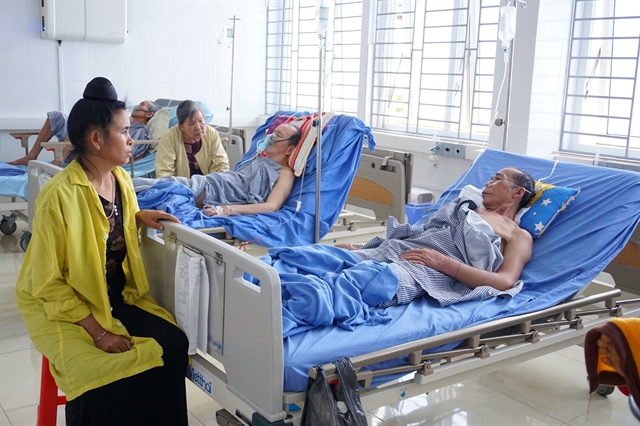 Politics & Law
Politics & Law

 |
| Patients with health insurance under treatment at Sơn La General Hospital in the northern mountainous province of Sơn La. — VNA/VNS Photo |
HÀ NỘI — The Ministry of Health is seeking feedback from relevant agencies on the draft amended Health Insurance Law, which proposes a roadmap to increase health insurance premiums from 2025 to reach a maximum of 6 per cent of the base salary or monthly income by 2035.
In the policy impact assessment report of the draft amended Health Insurance Law, the ministry stated that the current provisions on health insurance premiums are not balanced with the level of benefits and the scope of coverage for health insurance participants, so it is necessary to consider gradually increasing health insurance premiums.
The ministry said that the current Health Insurance Law stipulates the maximum payment of health insurance premium of up to 6 per cent of monthly salary, but there is no mechanism and roadmap for the Government to apply the increase, while the demand for expanding the coverage scope of the Health Insurance Fund is increasingly high.
Furthermore, the premium level and average nominal value of Việt Nam's health insurance is much lower than many countries in the region and worldwide.
The health insurance fund is formed from contributions from health insurance participants, profit from investment activities of the Fund as regulated by the Social Insurance Law, late payment interest, and other legal revenue sources.
Ninety percent of health insurance premiums collected annually are allocated and used for medical examinations and treatment; 10 per cent are allocated to the contingency fund, and the management expenses of the Health Insurance Fund, with a minimum of 5 per cent of health insurance premiums allocated to the contingency fund.
From 2010 to 2015, the spending rate of the Health Insurance Fund was 80-90 per cent, and the fund continuously had a surplus, with an accumulated surplus by the end of 2015 amounting to VNĐ49.3 trillion (US$1.99 billion).
From 2016 to 2020, after adjusting the prices of medical examination and treatment services by incorporating the salary into the prices, the Health Insurance Fund became unbalanced in terms of revenue and expenditure within the year. In 2017, the spending rate of the fund reached 111 per cent, with an overspending of VNĐ9.3 trillion ($376 million).
In 2021, due to the impact of the COVID-19 pandemic and prolonged social distancing measures, the number of medical visits decreased, leading to a decrease in medical expenses and the Health Insurance Fund returned to surplus.
However, by 2022, the medical expenses covered by health insurance again exceeded the Health Insurance Fund for the year by over VNĐ3 trillion ($121 million).
According to the ministry, in the coming years, there is expected to be a significant increase in expenditures from the Health Insurance Fund due to the increase in the prices of medical services.
The ministry’s Circular 22/2023 has adjusted the prices of healthcare services, in which the salary factor has been updated following the new base salary level.
Additionally, the roadmap for accurately calculating healthcare service costs, including the addition of management cost and depreciation cost, will also increase medical examination and treatment expenses in the future.
After the COVID-19 pandemic, the number of inpatient and outpatient visits has showed signs of returning to a high level.
According to the Vietnam Social Security’s reports, the inpatient rate in 2022 reached 10.4 per cent, even higher than this rate in the pre-pandemic period, while many new technical services and medicines are being considered for coverage by the health insurance fund.
Moreover, the ageing population trend in Việt Nam is happening rapidly with high-cost chronic non-communicable diseases among the elderly group. Therefore, the ministry said that there will be an imbalance between revenue and expenditure within the year, as well as difficulties in ensuring the sustainability of the Health Insurance Fund in the future.
Raising contribution level
In the policy impact assessment report of the draft amended Health Insurance Law, the ministry has proposed three options.
In the first option, the ministry proposes to increase the health insurance contribution level to 5.1 per cent of the monthly salary or unemployment benefits of employees from January 1, 2025, and to a maximum level of 6 per cent from January 1, 2035.
In the second option, the ministry proposes to increase the health insurance contribution level to 5.4 per cent of monthly salary from January 1, 2025, and to 6 per cent from January 1, 2035.
In the third option, the ministry will keep the maximum contribution level and not include a roadmap for increasing the contribution level in the amended law.
The ministry explained that the third option will not increase expenditure from the State budget or for businesses as budget revenue is still limited and businesses are still facing financial difficulties.
The ministry stated that studying the first and second options will be considered in the amendment of the Health Insurance Law in the future, when there are sufficient economic and social conditions, as well as enough time to study and assess policy impacts in more detail.
The amended Health Insurance Law is expected to be submitted to the National Assembly for passage at the seventh session of the 15th National Assembly in May.
By the end of 2023, nearly 93.7 million people nationwide participated in health insurance, with a coverage rate of over 93 per cent of the population.
Việt Nam aims to cover over 95 per cent of the population with health insurance by 2025. — VNS